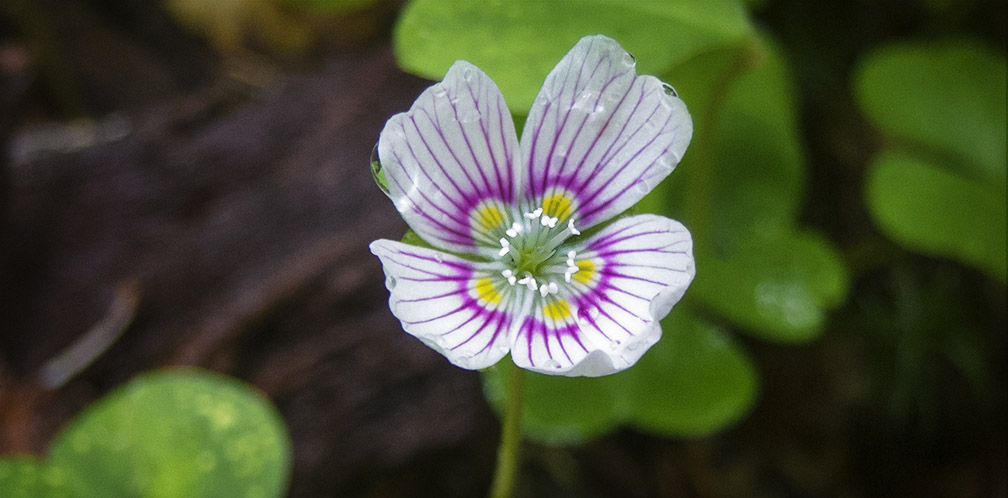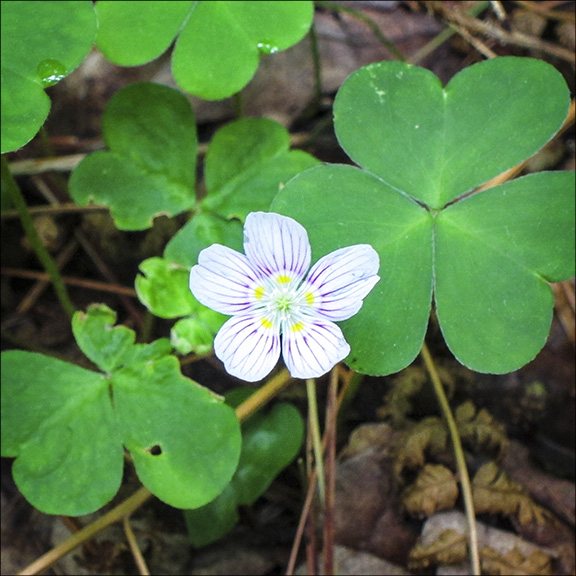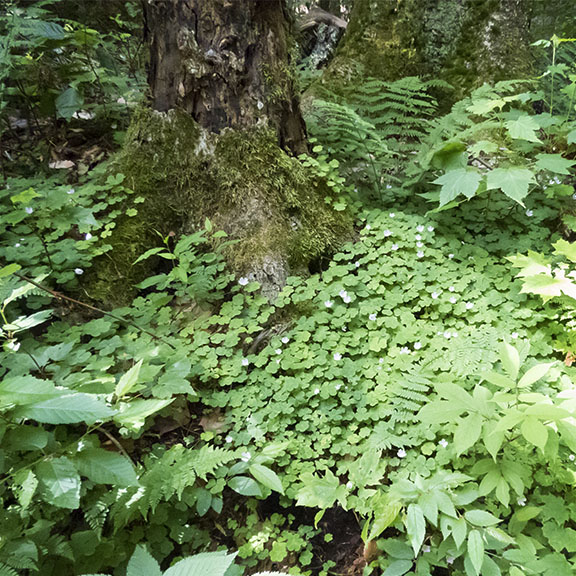Wildflowers of the Adirondacks:
Common Wood Sorrel (Oxalis montana)

Common Wood Sorrel (Oxalis montana) is a small, native Adirondack wildflower with clover-like foliage and small pink and white flowers that bloom in early summer. Common Wood Sorrel is a member of the Oxalis family. This plant is presumed extirpated in Ohio.
This plant has a long list of alternate common names, including: Wood Sorrel, White Wood-sorrel, Mountain Woodsorrel, Mountain Wood Sorrel, Northern Wood Sorrel, Common Wood-Sorrel, Wood-Shamrock, Common Woodsorrel, True Wood-sorrel, Wood-shamrock, Wood shamrock, Sleeping-beauty, American Wood-sorrel.
The genus name derives from the Greek word "oxys," meaning acid, which is a reference to the sour taste of the foliage. The term "montana" means "mountainous regions" in Latin.
Identification of Common Wood Sorrel

The Common Wood Sorrel is a low-growing plant, usually growing less than four inches in height. The flowering stem is hairy near the flower and often reddish towards the base.
The leaves of Common Wood Sorrel are green and clover-like. The leaf edges are smooth (without teeth). The leaves appear to be basal, meaning that they occur in a cluster at the base of the plant. Common Wood Sorrel leaves are compound, with three heart-shaped leaflets, each about 1/2 to one inch wide. The leaves, which have a sour taste, close at night.
Common Wood Sorrel flowers appear singly (one to a stalk). The symmetrical flowers are small (3/4 inch wide), with five white petals that are deeply notched. The petals have deep pink or purple veins and are splashed with yellow near the base. The flowers have ten stamens of unequal length. The flowers are pollinated by bees and other insects.
In the Adirondacks, Common Wood Sorrel flowers usually appear from mid-June to mid-July, depending on the weather. During years that spring comes early, you might find Common Wood Sorrel blooming in early June.
Common Wood Sorrel flowers are similar in coloring to those of Carolina Springbeauty, which also has white flowers veined in deep pink.
- However, Carolina Springbeauty petals lack the notches characteristic of Common Wood Sorrel.
- In addition, the shape of the leaves is very different. Carolina Springbeauty has lance-shaped leaves, contrasting with Common Wood Sorrel's clover-shaped leaves.
- Most importantly, the two plants bloom at very different times. Carolina Springbeauty is a spring ephemeral, which blooms in early spring before the hardwood trees leaf out, while Common Wood Sorrel blooms in early summer. So, if you find a low-growing plant with pink, candy-striped flowers in June or July, it's probably Common Wood Sorrel.
Uses of Common Wood Sorrel
Common Wood Sorrel has very limited uses as a food or medicine. The sour, edible clover-like leaves are said to be good if used sparingly in salads. The tender stems and leaves have also been used to make tea. Several sources, noting that all parts of the plant are toxic, warn against excessive consumption over an extended period of time, since this may inhibit the absorption of calcium by the body. This plant was not widely used by native Americans.
Wildlife Value of Common Wood Sorrel
Common Wood Sorrel's value for wildlife is negligible. Mourning Doves reportedly eat the seeds, leaves, and bulbs. Dark-eyed Juncos and Horned Larks are said to feed on seeds. There are no other reported wildlife uses.
Distribution of Common Wood Sorrel

The plant is native to eastern North America, including eastern Canada and the north-central and eastern United States. In Canada, Common Wood Sorrel's range includes Manitoba east to southern Labrador and south to Nova Scotia. In the United States, Common Wood Sorrel may be found from Minnesota across the North Central States to New England, as well as in the mountainous regions of North Carolina and Tennessee.
In New York State, Common Wood Sorrel occurs in most counties in the eastern part of the state. It can be found in most counties within the Adirondack Park Blue Line, except Clinton, Fulton, and Washington counties.
Habitat of Common Wood Sorrel
Common Wood Sorrel is shade-tolerant, meaning that it can grow in the shade although growth rates may be best in partial sun. It will grow on very acid sites and well to imperfectly drained places.
Common Wood Sorrel is characterized as a climax understory species, meaning that it is most abundant in mature forests. On the Forest Ecosystem Research and Demonstration Area (FERDA) plots at the Paul Smiths VIC, Common Wood Sorrel decreased in abundance on most of the logged blocks a decade after the cuts.
Look for Common Wood Sorrel in a variety of habitats, including conifer, mixed woods, and northern hardwood forests, in elevations ranging from 1,000 to 4900 feet. In the Adirondacks, Common Wood Sorrel is found in a wide variety of ecological communities:
You can find this plant along sections of virtually all trails covered here.
- In mixed wood forests, Common Wood Sorrel can be seen growing near Eastern Hemlock, Red Maple, and Yellow Birch. Striped Maple is often prominent as a mid-story tree, with Hobblebush at lower levels.
- Ground-layer herbs often seen growing with Common Wood Sorrel include ferns such as Intermediate Wood Fern, with Hay-scented Fern and New York Fern growing in forest gaps.
- Other wildflowers include Canada Mayflower, Wild Sarsaparilla, Partridgeberry, Indian Cucumber-root, Foamflower, and Starflower.
References
Michael Kudish. Adirondack Upland Flora: An Ecological Perspective (The Chauncy Press, 1992), pp. 42, 174.
New York Flora Association. New York Flora Atlas. Northern Wood Sorrel. Oxalis montana Raf. Retrieved 21 March 2017.
United States Department of Agriculture. The Plants Database. Oxalis montana Raf. Mountain Woodsorrel. Retrieved 21 March 2017.
United States Department of Agriculture. Fire Effects Information System (FEIS). Species Reviews. Oxalis montana. Retrieved 22 March 2017.
Flora of North America. Oxalis montana Rafinesque. Retrieved 21 March 2017.
New England Wildflower Society. Go Botany. Oxalis montana Raf. Northern Wood Sorrel. Retrieved 21 March 2017.
New York State. Department of Environmental Conservation. New York Natural Heritage Program. Ecological Communities of New York State. Second Edition (March 2014), pp. 71-72, 72, 104-105, 121, 122-123, 123, 123-124, 124. Retrieved 17 October 2015.
New York Natural Heritage Program. 2015. Online Conservation Guide for Alpine Krummholz. Retrieved 22 February 2017.
New York Natural Heritage Program. 2015. Online Conservation Guide for Balsam Flats. Retrieved 22 February 2017.
New York Natural Heritage Program. 2015. Online Conservation Guide for Beech-Maple Mesic Forest. Retrieved 22 February 2017.
New York Natural Heritage Program. 2015. Online Conservation Guide for Hemlock-Hardwood Swamp. Retrieved 22 February 2017.
New York Natural Heritage Program. 2015. Online Conservation Guide for Mountain Fir Forest. Retrieved 22 February 2017.
New York Natural Heritage Program. 2015. Online Conservation Guide For Mountain Spruce-Fir Forest. Retrieved 22 February 2017.
New York Natural Heritage Program. 2015. Online Conservation Guide for Spruce Flats. Retrieved 22 February 2017.
New York Natural Heritage Program. 2015. Online Conservation Guide for Spruce-Fir Swamp. Retrieved 22 February 2017.
New York Natural Heritage Program. 2015. Online Conservation Guide for Spruce-Northern Hardwood Forest. Retrieved 22 February 2017.
New York State. Adirondack Park Agency. Preliminary List of Species Native Within the Adirondack Park Listed Alphabetically by Scientific Name and Sorted by Habit. Volume 1. Updated 10.23.2006, p. 29. Retrieved 26 January 2017.
Connecticut Botanical Society. Common Wood-sorrel (Northern Wood-sorrel). Oxalis montana Raf. Retrieved 21 March 2017.
University of Wisconsin. Flora of Wisconsin. Oxalis acetosella subsp. montana L. Retrieved 21 March 2017.
Minnesota Wildflowers. Oxalis acetosella (Common Wood Sorrel). Retrieved 21 March 2017.
Lady Bird Johnson Wildflower Center. Oxalis montana Raf. Retrieved 21 March 2017.
Anne McGrath. Wildflowers of the Adirondacks (EarthWords, 2000), p. 29, Plate 14.
Roger Tory Peterson and Margaret McKenny. A Field Guide to Wildflowers. Northeastern and North-central North America (Houghton Mifflin Company, 1968), pp. 30-31, 138-139.
Doug Ladd. North Woods Wildflowers (Falcon Publishing, 2001), p. 84.
Lawrence Newcomb. Newcomb's Wildflower Guide (Little Brown and Company, 1977), pp. 184-185.
David M. Brandenburg. Field Guide to Wildflowers of North America (Sterling Publishing Company, Inc., 2010), p. 397.
Timothy Coffey. The History and Folklore of North American Wildflowers (FactsOnFile, 1993), pp. 146-147.
William Carey Grimm. The Illustrated Book of Wildflowers and Shrubs (Stackpole Books, 1993), pp. 158-159.
Wilbur H. Duncan and Marion B. Duncan. Wildflowers of the Eastern United States (The University of Georgia Press, 1999), p. 43.
National Audubon Society. Field Guide to North American Wildflowers. Eastern Region. (Alfred A. Knopf, 2001), pp. 670, Plate 446 .
William K. Chapman et al., Wildflowers of New York in Color (Syracuse University Press, 1998), pp. 10-11.
Mark J. Twery, at al. Changes in Abundance of Vascular Plants under Varying Silvicultural Systems at the Forest Ecosystem Research and Demonstration Area, Paul Smiths, New York. USDA Forest Service. Research Note NRS-169. Retrieved 22 January 2017, p. 8.
Alexander C. Martin, Herbert S. Zim, and Arnold L. Nelson. American Wildlife & Plants. A Guide to Wildlife Food Habits (Dover Publications, 1951), pp. 94-96, 111-112, 129, 194-195, 200, 203-204, 241-242, 408-409.
Plants for a Future. Oxalis montana – Raf. Mountain Wood Sorrel. Retrieved 22 March 2017.
Lee Allen Peterson. A Field Guide to Edible Wild Plants. Eastern and Central North America (Houghton Mifflin Company, 1977), pp. 104-105.
Bradford Angier. Field Guide to Edible Wild Plants. Revised and Updated. (Stackpole Books, 2008), pp. 266-267.
University of Michigan. Native American Ethnobotany. A Database of Foods, Drugs, Dyes and Fibers of Native American Peoples, Derived from Plants. Oxalis montana Raf. Mountain Woodsorrel. Retrieved 22 March 2017.
Nancy G. Slack and Allison W. Bell. Adirondack Alpine Summits: An Ecological Field Guide (Adirondack Mountain Club, Inc., 2006), p. 26.
Allen J. Coombes. Dictionary of Plant Names (Timber Press, 1994), p. 132.
